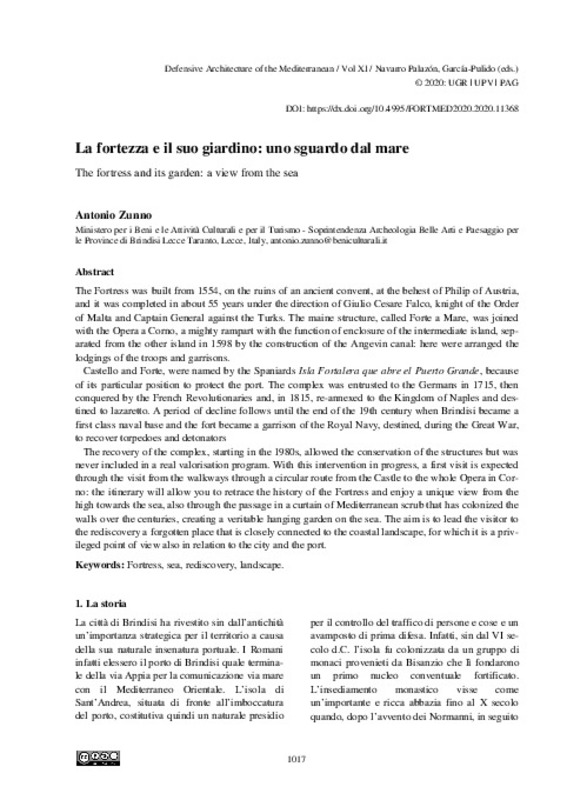JavaScript is disabled for your browser. Some features of this site may not work without it.
Buscar en RiuNet
Listar
Mi cuenta
Estadísticas
Ayuda RiuNet
Admin. UPV
La fortezza e il suo giardino: uno sguardo dal mare
Mostrar el registro sencillo del ítem
Ficheros en el ítem
| dc.contributor.author | Zunno, Antonio
|
es_ES |
| dc.coverage.spatial | east=17.9417616; north=40.6327278; name= Brindisi BR, Itàlia | es_ES |
| dc.date.accessioned | 2020-07-07T07:08:12Z | |
| dc.date.available | 2020-07-07T07:08:12Z | |
| dc.date.issued | 2020-05-15 | |
| dc.identifier.isbn | 9788490488560 | |
| dc.identifier.uri | http://hdl.handle.net/10251/147551 | |
| dc.description.abstract | [EN] The Fortress was built from 1554, on the ruins of an ancient convent, at the behest of Philip of Austria, and it was completed in about 55 years under the direction of Giulio Cesare Falco, knight of the Order of Malta and Captain General against the Turks. The maine structure, called Forte a Mare, was joined with the Opera a Corno, a mighty rampart with the function of enclosure of the intermediate island, separated from the other island in 1598 by the construction of the Angevin canal: here were arranged the lodgings of the troops and garrisons. Castello and Forte, were named by the Spaniards Isla Fortalera que abre el Puerto Grande, because of its particular position to protect the port. The complex was entrusted to the Germans in 1715, then conquered by the French Revolutionaries and, in 1815, re-annexed to the Kingdom of Naples and destined to lazaretto. A period of decline follows until the end of the 19th century when Brindisi became a first class naval base and the fort became a garrison of the Royal Navy, destined, during the Great War, to recover torpedoes and detonators The recovery of the complex, starting in the 1980s, allowed the conservation of the structures but was never included in a real valorisation program. With this intervention in progress, a first visit is expected through the visit from the walkways through a circular route from the Castle to the whole Opera in Corno: the itinerary will allow you to retrace the history of the Fortress and enjoy a unique view from the high towards the sea, also through the passage in a curtain of Mediterranean scrub that has colonized the walls over the centuries, creating a veritable hanging garden on the sea. The aim is to lead the visitor to the rediscovery a forgotten place that is closely connected to the coastal landscape, for which it is a privileged point of view also in relation to the city and the port. | es_ES |
| dc.language | Italiano | es_ES |
| dc.publisher | Editorial Universitat Politècnica de València | es_ES |
| dc.rights | Reconocimiento - No comercial - Sin obra derivada (by-nc-nd) | es_ES |
| dc.subject | Fortifications | es_ES |
| dc.subject | Mediterranean | es_ES |
| dc.subject | Modern age | es_ES |
| dc.subject | Built Heritage | es_ES |
| dc.subject | Fortress | es_ES |
| dc.subject | Sea | es_ES |
| dc.subject | Rediscovery | es_ES |
| dc.subject | Landscape | es_ES |
| dc.title | La fortezza e il suo giardino: uno sguardo dal mare | es_ES |
| dc.title.alternative | The fortress and its garden: a view from the sea | es_ES |
| dc.type | Capítulo de libro | es_ES |
| dc.type | Comunicación en congreso | es_ES |
| dc.identifier.doi | 10.4995/FORTMED2020.2020.11368 | |
| dc.rights.accessRights | Abierto | es_ES |
| dc.description.bibliographicCitation | Zunno, A. (2020). La fortezza e il suo giardino: uno sguardo dal mare. Editorial Universitat Politècnica de València. 1017-1024. https://doi.org/10.4995/FORTMED2020.2020.11368 | es_ES |
| dc.description.accrualMethod | OCS | es_ES |
| dc.relation.conferencename | FORTMED2020 - Defensive Architecture of the Mediterranean | es_ES |
| dc.relation.conferencedate | Octubre 01-03,2020 | es_ES |
| dc.relation.conferenceplace | Granada, Spain | es_ES |
| dc.relation.publisherversion | http://ocs.editorial.upv.es/index.php/FORTMED/FORTMED2020/paper/view/11368 | es_ES |
| dc.description.upvformatpinicio | 1017 | es_ES |
| dc.description.upvformatpfin | 1024 | es_ES |
| dc.type.version | info:eu-repo/semantics/publishedVersion | es_ES |
| dc.relation.pasarela | OCS\11368 | es_ES |








